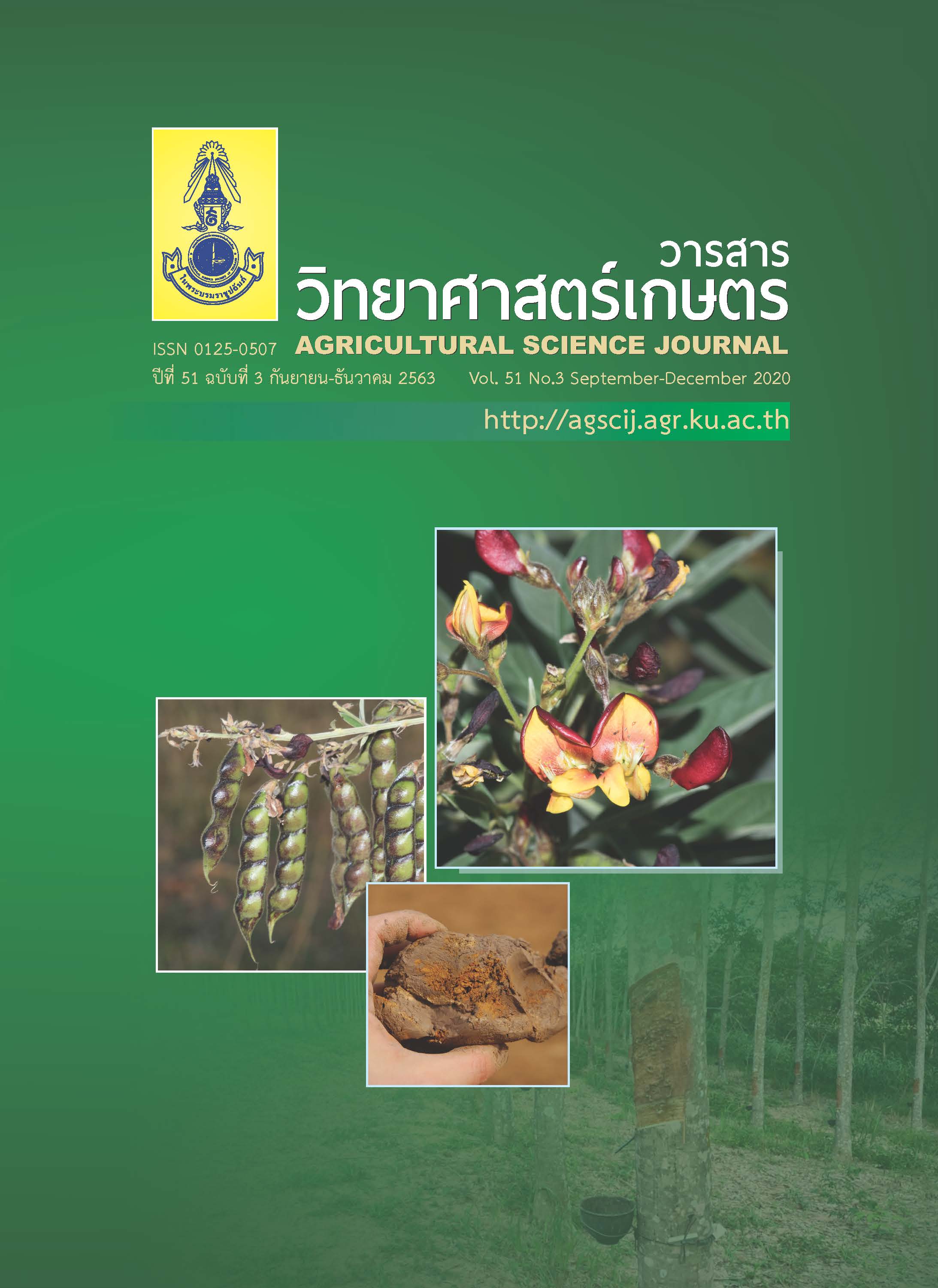Evaluation of Potential Buffering Capacity of Potassium in Acid Sulfate Soils, Central Plain of Thailand
Main Article Content
Abstract
Evaluation of the potential buffering capacity of potassium (PBCk) using the quantity/ intensity (Q/I) concept provides a satisfactory measurement of K availability in soils. The Q/I relationship parameters can be evaluated soil K content (∆K°), the ability of the soil to provide K for plant uptake (ARek ), and also the capacity of the soil to maintain K+ availability. Representative acid sulfate soils in the Central Plain of Thailand including Ayutthaya soil series (Ay1 and Ay2), Sena soil series (Se1 and Se2), and Rangsit soil series (Rs1 and Rs2) were collected to determine various forms of K contents and PBCk . The result showed that most of the studied soils contained a high level of available K (water soluble K + exchangeable K) except for Se1 and Se2 which showed a moderate level of available K. The PBCk values of the studied soils ranged from 27.5–105 (cmol kg–1)/(mol L–1) 1/2 and most soils showed the low to moderate level of ability to maintain K+ availability. The PBCk values of studied soils positively correlated with soil pH (R2 = 0.33, P < 0.05). The available K (∆K°) values were mainly negative, indicating soil K+ can be easily released for plant uptake when adding K fertilizers to the studied soils. The activity ratio of soil K+ (ARke) of most acid sulfate soils ranged from 0.001 to 0.01 (mol L–1)1/2, indicating that most of soil K+ content was mainly adsorbed on the exchange sites of clay mineral’s edges, and such soil K+ would moderately easily release for plant uptake.
Article Details
References
Chapman, H.D. 1965. Cation exchange capacity, pp. 891–901. In C.A. Black, ed. Methods of Soil Analysis. Part II. Chemical and Microbiological Properties. Agronomy No. 9. American Society of Agronomy, Madison, Wisconsin, USA.
Darunsontaya, T., N. Chittamart, W. Jindaluang, A. Suddhiprakarn, R. Jaroenchasri and I. Kheoruenromne. 2019. Assessment of Potential Lands for Oil Palm Growing Basing on Properties of Soils and Climate in Central Plain and Eastern Region of Thailand. Agricultural Research Development Agency (Public Organization). (in Thai)
Dobermann, A. and T.H. Fairhurst. 2000. Rice: Nutrient Disorders & Nutrient Management. Oxford Graphic Printers Pte Ltd, Singapore.
Herbert, R. 1997. Properties of goethite and jarosite precipitated from acid groundwater, Dalarna, Sweden. Clays Clay Miner. 45: 261–273.
Hosseinpur, A.R. and M.R. Tadayon. 2013. Potassium quantity–intensity parameters and their correlation with bean plant indices in some calcareous soils. Commun. Soil Sci. Plant Anal. 44: 1480–1488.
Jackson, M.L. 1965. Soil Chemical Analysis: Advanced Course. Department of Soils, University of Wisconsin, Madison, Wisconsin, USA.
Kheoruenromne, I. 1990. Soils of Thailand: Characteristics, Distribution and Uses. Department of Soil Science, Faculty of Agriculture, Kasetsart University, Bangkok. (in Thai)
Kheoruenromne, I. 2007. Acid Sulfate Soils in Thailand. Kasetsart University Press, Bangkok. 37 pp. (in Thai).
Land Development Department. 2015. State of Soil and Land Resources of Thailand. Land Development Department, Ministry of Agriculture and Cooperatives, Bangkok. 304 pp. (in Thai)
Murphy, J. and J.P. Riley. 1962. A modified single solution method for the determination of phosphate in natural waters. Anal. Chim. Acta. 27: 31–36.
National Soil Survey Center. 1996. Soil Survey Laboratory Methods Manual. Soil Survey Investigations Report No. 42, Version 3.0. Natural Conservation Service, United States Department of Agriculture.
Osotsapar, Y. 2003. Plant Nutrition. 2nd edition. Kasetsart University Press, Bangkok. 548 pp. (in Thai)
Osotsapar, Y., A. Wongmaneeroj and C. Hongprayoon. 2013. Fertilizers for Sustainable Agriculture. 3rd edition. Kasetsart University Press, Bangkok. 519 pp. (in Thai).
Palykaew, S. 2016. Suitability of Acid Sulfate Soils for Growing Oil Palm in Central Plain, Thailand. MS Thesis, Kasetsart University, Bangkok. (in Thai)
Peech, M. 1965. Exchange acidity, pp. 905–913. In C.A. Black, ed. Methods of Soil Analysis. Part II. Chemical and Microbiological Properties. Agronomy No. 9. American Society of Agronomy, Madison, Wisconsin, USA.
Pratt, P.E. 1965. Potassium, pp. 1023–1031. In C.A. Black, ed. Methods of Soil Analysis. Part II. Chemical and Microbiological Properties. Agronomy No. 9. American Society of Agronomy, Madison, Wisconsin, USA.
Rao, C.S., A.S. Rao, K.V. Rao, B. Venkateswarlu and A.K. Singh. 2010. Categorisation of districts based on nonexchangeable potassium: implications in efficient K fertility management in Indian agriculture. Indian J. Fert. 6: 40–54.
Rungruang, C. 2017. Effect of Hydrated Lime and Dolomite on Potential Buffering Capacity of Acid Sulfate Soils in Thailand. BS Special Problem. Kasetsart University, Bangkok. (in Thai)
Rupa, T.R., S. Srivastava, A.S. Swarup, D.A. Sahoo and B.R. Tembhare. 2003. The availability of potassium in Aeric Haplaquept and Typic Haplustert as affected by long–term cropping, fertilization and manuring. Nutr. Cycl. Agroecosys. 65: 1–11.
Soil Survey Division Staff. 1993. Soil Survey Manual. Handbook No. 18. United States Department of Agriculture, Washington D.C., USA.
Sparks, D.L. and W.C. Liebhardt. 1981. Effect of long–term lime and potassium applications on quantity-intensity (Q/I) relationships in sandy soil. Soil Sci. Soc. Am. J. 45: 786–790.
Suttanukool, P., T. Darunsontaya and W. Jindaluang. 2019. A study on the quantity/intensity relationships of potassium of sugarcane growing soils eastern Thailand. Commun. Soil Sci. Plant Anal. 50(2): 153–163.
Thomas, G.W. 1982. Exchangeable cations, pp. 159–165. In A.L. Page, ed. Methods of Soil Analysis. Part 2. Chemical and Microbiological Properties. 2nd edition. American Society of Agronomy, Madison, Wisconsin, USA.
van Schouwenburg, J.C.H. and A.C. Schuffelen. 1963. Potassium–exchange behaviour of an illite. Neth. J. Agri. Sci. 11(1): 13–22.
Walkley, A. and I.A. Black. 1934. An examination of the digestion method for determining soil organic matter and a proposed modification of the chromic acid titration method. Soil Sci. 37: 29–38.
Wang, J.J., D.L. Harrell and P.F. Bell. 2004. Potassium buffering characteristics of three soils low in exchangeable potassium. Soil Sci. Soc. Am. J. 68: 654–661.
Wooldridge, J. 1990. Effect of liming and parent material on the potassium quantity/intensity relationships of some upland soils of the Western Cape. S. Afr. J. Plant Soil. 7(1): 62–67.
Zharikova, E.A. 2004. Potential buffer capacity of soils with respect to potassium (by the example of the Amur River region). Eurasian Soil Sci. 37(7): 710–717.


